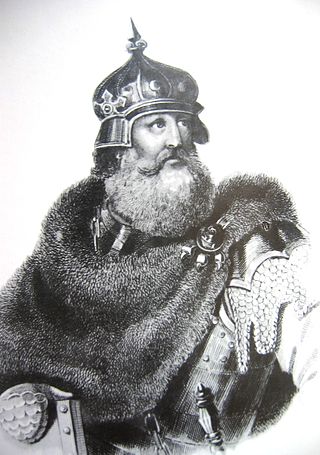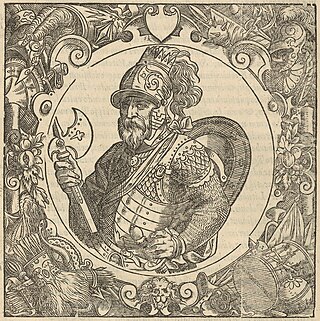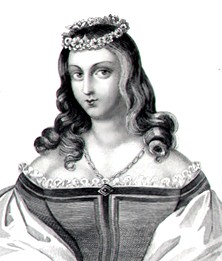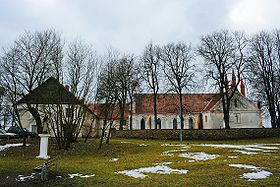
Trakai is a city and lake resort in Lithuania. It lies 28 kilometres west of Vilnius, the capital of Lithuania or just 7 kilometres from the administrative limits of the Lithuanian capital city. Because of its proximity to Vilnius, Trakai is a popular tourist destination. Trakai is the administrative centre of Trakai district municipality. The city is inhabited by 5,357 people, according to 2007 estimates. A notable feature of Trakai is that the city was built and preserved by people of different nationalities. Historically, communities of Karaims, Tatars, Lithuanians, Russians, Jews and Poles lived here.

Vytautas, also known as Vytautas the Great, was a ruler of the Grand Duchy of Lithuania. He was also the prince of Grodno (1370–1382), prince of Lutsk (1387–1389), and the postulated king of the Hussites.

Kęstutis was the Grand Duke of Lithuania. He was the Duke of Trakai and governed the Grand Duchy of Lithuania, 1342–1382, together with his brother Algirdas, and with his nephew Jogaila.

The Columns of Gediminas or Pillars of Gediminas are one of the earliest symbols of Lithuania and its historical coats of arms. They were used in the Grand Duchy of Lithuania, initially as a rulers' personal insignia, a state symbol, and later as a part of heraldic signs of leading aristocracy.

Dzūkija or Dainava is one of five ethnographic regions of Lithuania. Dzūkija is a cultural region defined by traditional lifestyles and dialects of the local Lithuanian population and has never been defined as a political or administrative unit. Traditionally, Alytus is regarded as the capital of the region and largest city. Although Vilnius is surrounded by Dzūkija, the city itself is not considered as a part of any ethnographic region in most cases.

Skirgaila was a regent of the Grand Duchy of Lithuania for his brother Jogaila from 1386 to 1392. He was the son of Algirdas, Grand Duke of Lithuania, and his second wife Uliana of Tver.
Bayernburg is the name of three separate wooden castles of the Teutonic Order in different locations along the Neman River in the Grand Duchy of Lithuania during the Lithuanian Crusade. Their exact locations are not known and historians provide conflicting versions. The first fortress was built in 1337 by guest crusaders, including Henry XIV, Duke of Bavaria, in whose honor it was named after Bavaria. Emperor Louis IV declared it the capital of the to-be-conquered Lithuania. The newly built castle withstood a 22-day siege by Grand Duke Gediminas, but was abandoned by the Order in 1344. The Teutons burned down the first Bayernburg and built a brand new fortress a little closer to Prussia. The second Bayernburg withstood a six-day Lithuanian attack in 1381 but was burned down in July 1384 by Vytautas when he betrayed the Order at the conclusion of the Lithuanian Civil War (1381–84). The third Bayernburg was built in spring 1387 where Georgenburg stood but the new name did not gain acceptance and the fortress continued to be known as Georgenburg. This fortress was captured and burned down by Vytautas in April 1403 during the first Samogitian uprising.

Birutė was the second wife of Kęstutis, Grand Duke of Lithuania, and mother of Vytautas the Great. There is very little known about Birutė's life, but after her death a cult worshiping her developed among Lithuanians, especially in Samogitia.

Trakai Peninsula Castle is one of the castles in Trakai, Lithuania. It is located on a peninsula between southern Lake Galvė and Lake Luka. Built around 1350–1377 by Kęstutis, Duke of Trakai, it was an important defensive structure protecting Trakai and Vilnius, capital of the Grand Duchy of Lithuania, against attacks of the Teutonic Knights. Much of the castle was destroyed in the 17th century. Remaining walls and towers are preserved and protected by the Trakai Historical National Park.

Trakai Island Castle is an island castle located in Trakai, Lithuania, on an island in Lake Galvė. The construction of the stone castle was begun in the 14th century by Kęstutis, and around 1409 major works were completed by his son Vytautas the Great, who died in this castle in 1430. Trakai was one of the main centers of the Grand Duchy of Lithuania and the castle held great strategic importance. The castle was rebuilt in the 1950s–1960s by Lithuanian initiative, although it had received resistance from Soviet authorities. The Trakai History Museum was established after the reconstruction.

Senieji Trakai is a historic Lithuanian village located 3 kilometres (1.9 mi) east of Trakai. According to the Lithuanian census of 2011, it has 1,396 inhabitants – Lithuanians, Poles and Russians. The Saint Petersburg–Warsaw Railway passes through Senieji Trakai.

Jogaila, later Władysław II Jagiełło (ca.1351/1361–1434), was a Grand Duke of Lithuania and from 1386 King Jadwiga's husband and jure uxoris King of Poland. In Lithuania, he held the title Didysis Kunigaikštis, translated as Grand Duke or Grand Prince.

The family of Gediminas is a group of family members of Gediminas, Grand Duke of Lithuania, who interacted in the 14th century. The family included the siblings, children, and grandchildren of the Grand Duke and played the pivotal role in the history of Lithuania for the period as the Lithuanian nobility had not yet acquired its influence. Gediminas was also the forefather of the Gediminid dynasty, which ruled the Grand Duchy of Lithuania from 1310s or 1280s to 1572.

The Duchy of Lithuania was a state-territorial formation of ethnic Lithuanians that existed from the 13th century to 1413. For most of its existence, it was a constituent part and a nucleus of the Grand Duchy of Lithuania. Other alternative names of the territorial formation, used in different periods, were Aukštaitija or Land of Lithuania, Duchy of Vilnius, Lithuania proper, or simply Lithuania.

The Lithuanian Civil War of 1389–1392 was the second civil conflict between Jogaila, King of Poland and Grand Duke of Lithuania, and his cousin Vytautas. At issue was control of the Grand Duchy of Lithuania, then the largest state in Europe. Jogaila had been crowned King of Poland in 1386; he installed his brother Skirgaila as ruler of Lithuania. Skirgaila proved unpopular and Vytautas attempted to depose him. When his first attempt to take the capital city of Vilnius failed, Vytautas forged an alliance with the Teutonic Knights, their common enemy – just as both cousins had done during the Lithuanian Civil War between 1381 and 1384. Vytautas and the Knights unsuccessfully besieged Vilnius in 1390. Over the next two years it became clear that neither side could achieve a quick victory, and Jogaila proposed a compromise: Vytautas would become Grand Duke and Jogaila would remain Superior Duke. This proposal was formalized in the Ostrów Agreement of 1392, and Vytautas turned against the Knights. He went on to reign as Grand Duke of Lithuania for 38 years, and the cousins remained at peace.

The Lithuanian Civil War of 1381–1384 was the first struggle for power between the cousins Jogaila, Grand Duke of Lithuania and later King of Poland, and Vytautas the Great. It began after Jogaila signed the Treaty of Dovydiškės with the Teutonic Knights which was aimed against his uncle Kęstutis, father of Vytautas. Kęstutis briefly seized power in the Grand Duchy, but was betrayed by adherents of Jogaila primarily from Vilnius. During negotiations for a truce Kęstutis and Vytautas were arrested and transported to the Kreva Castle. Kęstutis died there a week later but Vytautas managed to escape and then sought an alliance with the Teutonic Knights. Subsequently their joint forces raided Lithuanian lands. Eventually the cousins were reconciled as Jogaila needed internal stability in anticipation of negotiations with the Grand Duchy of Moscow and the Kingdom of Poland regarding the possible Christianization of Lithuania. The war did not settle the power struggle; it continued during the next Lithuanian Civil War (1389–1392) which was resolved by the signing of the Ostrów Agreement. After more than ten years of struggle, Vytautas finally became the Grand Duke of Lithuania and ruled the country for thirty-eight years.

Duchy of Trakai was a subdivision of the Grand Duchy of Lithuania during the 14th and early 15th centuries. The Duke of Trakai was an important position held either by the Grand Duke of Lithuania himself or his second-in-command.

Lida Castle is a historic, medieval castle in Lida, Grodno Region, western Belarus.

Gediminas was Grand Duke of Lithuania from 1315 or 1316 until his death in 1341.

The Lithuanian Crusade was a series of campaigns by the Teutonic Order and the Livonian Order under the pretext of forcibly Christianizing the pagan Grand Duchy of Lithuania. The Livonian Order occupied Riga in 1202 and in the 1230s they settled in Chełmno Land, a fief of Poland. They first conquered other neighboring Baltic tribes—Curonians, Semigallians, Latgalians, Selonians, and Old Prussians—in the Livonian Crusade and Prussian Crusade.



















